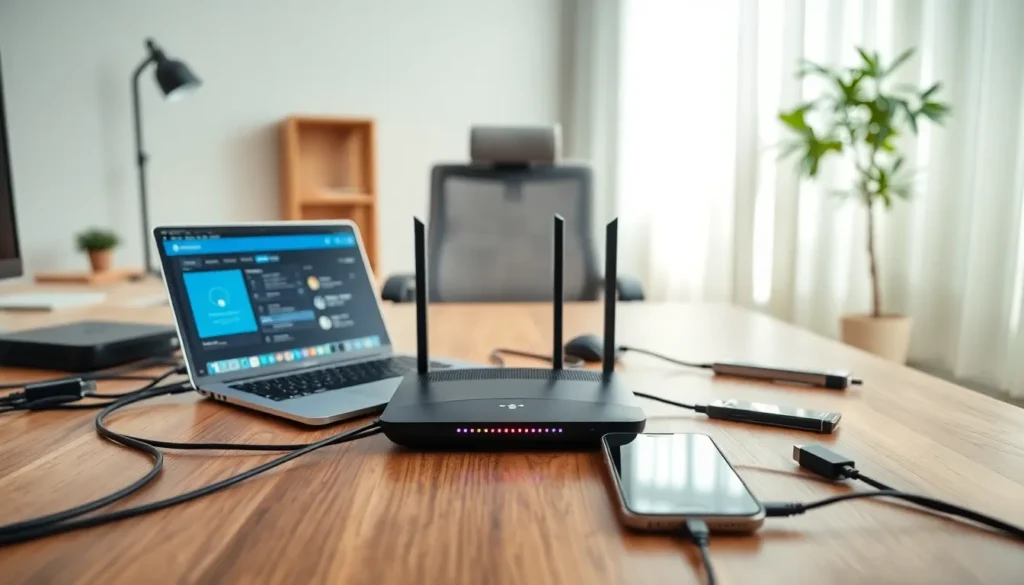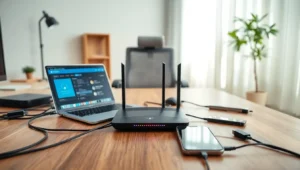Have you ever found yourself wrestling with wires and devices just to get your entertainment fix? You’re not alone. Home networking can feel like a labyrinth of confusing connections and tech jargon. But fear not, this guide is here to demystify the technical twists and turns, making home networking less of a circus act and more of a walk in the park. With some humor and know-how, we’ll help you create a robust home network that smoothly handles everything from binge-watching to video calls with family. Let’s immerse.
Table of Contents
ToggleUnderstanding Home Networking Basics

Home networking refers to the technology that allows devices in a residence to connect to one another, as well as to the internet. Imagine it as the highways and byways that help your devices communicate. Just like traffic signals help direct cars, routers manage data among various devices, ensuring smooth and efficient transfers.
In this digital age, home networks have become essential for numerous activities. Streaming videos, playing online games, or just sending emails all rely on a solid home network. Understanding the basics provides the foundation for optimizing performance and troubleshooting issues later.
Types of Home Networks
When it comes to home networks, one size certainly doesn’t fit all. There are several types, each tailored to different needs.
- Wired Networks: These use Ethernet cables to connect devices directly to a router. They’re reliable, fast, and immune to wireless interference, making them ideal for gamers or heavy users.
- Wireless Networks (Wi-Fi): These are the most common at home, allowing devices to connect without the hassle of cables. The convenience can sometimes lead to interference and slower speeds, but advancements like Wi-Fi 6 are improving performance.
- Powerline Networks: If extending your Wi-Fi signal seems daunting, powerline networking might just save the day. This technology uses the existing electrical wiring to transmit data, simplifying connections throughout the home.
Choosing the right type often depends on household size, internet use, and specific needs.
Essential Components of a Home Network
Every home network is built on essential components, each playing an important role. Anyone setting up a network should consider the following:
- Router: This is the heart of the network, distributing internet access to various devices.
- Modem: Often mistaken for a router, this device connects to your ISP and converts signals for internet access.
- Switch: Used primarily in wired networks, it helps manage multiple connections without slowing down the network.
- Access Points: These expand wireless coverage, especially in larger homes, giving devices access to network resources.
Investing in quality components enhances performance and durability.
Setting Up Your Home Network
Setting up a home network may sound overwhelming, but breaking it down makes it manageable.
Common Home Networking Issues and Solutions
Even the best home networks can run into issues. Here are some common problems and their solutions:
- Slow Internet Speeds: This could stem from high traffic or outdated hardware. Restarting the router often helps, as does upgrading to a newer model.
- Wi-Fi Dead Zones: If certain areas of the home receive weak signals, consider using range extenders or repositioning the router.
- Frequent Disconnections: This can often result from interference from other devices or overcrowded networks. Changing the channel on your router settings or limiting the number of connected devices typically resolves this.
Enhancing Your Home Network Performance
Optimizing home network performance can make a world of difference. Here are some strategies to boost speeds and reliability:
- Positioning: Place your router in a central location to maximize coverage. Avoid obstacles such as thick walls or large furniture.
- Regular Updates: Keeping firmware updated ensures the router remains secure and functional, taking advantage of the latest technology.
- Network Security: Strong Wi-Fi passwords protect against unauthorized access, potentially slowing down your network.
Future Trends in Home Networking
As technology evolves, so too does home networking. A few key trends include:
- Mesh Networks: Offering robust coverage across large spaces, these systems use multiple nodes to eliminate dead zones.
- Smart Home Integration: With smarter devices on the rise, home networks will increasingly need to accommodate IoT devices, requiring more from bandwidth and security.
- Wi-Fi 6 and Beyond: New standards are being introduced that promise increased speeds and efficiency, supporting more devices seamlessly.
Staying informed about these trends will help homeowners keep their networks future-proof.





